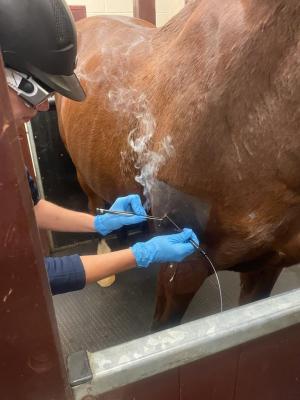Equine Therapy Success Stories: Genuine People, Real Emotional Transformations
Equine Therapy Success Stories: Genuine People, Real Emotional Transformations
Blog Article
Laser Treatment in Horse Treatment: A Modern Strategy to Improving Equine Health
Laser therapy has actually arised as a pivotal method in equine therapy, making use of focused light energy to foster cellular fixing and expedite recovery from a range of conditions. By boosting mitochondrial task and increasing ATP production, laser treatment not just enhances blood circulation yet also offers substantial pain relief.
Comprehending Laser Therapy
Laser therapy, a non-invasive treatment modality, has gained significant traction in equine medication due to its efficiency in advertising recovery and pain alleviation. Boosted ATP degrees accelerate tissue repair work processes and lower swelling, making laser treatment specifically effective for dealing with bone and joint injuries, injuries, and various other inflammatory problems in equines.
There are a number of kinds of lasers made use of in equine therapy, each with specific wavelengths and power results customized to different therapeutic requirements. Low-level laser treatment (LLLT), also known as cool laser therapy, employs lower power levels to stimulate cell feature without creating thermal damages. High-intensity laser therapy (HILT), on the other hand, makes use of higher power degrees to accomplish deeper tissue penetration and more substantial therapeutic results.
Veterinarians utilize numerous laser devices and strategies depending on the condition being treated and the wanted depth of cells infiltration. Appropriate training and know-how are important for ensuring the risk-free and reliable application of laser therapy, consequently optimizing its therapeutic capacity while minimizing dangers.
Advantages for Equine Health
With a solid understanding of how laser therapy works, it is essential to explore its various benefits for equine health and wellness. Among the key benefits is its capability to accelerate tissue repair and cell growth. By stimulating mobile feature, laser treatment advertises faster injury healing and aids in the regeneration of damaged tissues. This can be particularly useful in minimizing healing times for equines dealing with injuries.
In addition, laser treatment has actually been revealed to boost blood circulation, thus boosting blood circulation to affected locations. Enhanced flow makes sure that important nutrients and oxygen are provided a lot more successfully, facilitating the healing process. Additionally, laser therapy's anti-inflammatory impacts help in decreasing swelling and discomfort, which is vital for the general health of the steed.
Discomfort monitoring is another significant advantage. By releasing endorphins and obstructing pain signals, laser therapy gives efficient, non-invasive relief from both severe and chronic pain. This can contribute to enhanced mobility and high quality of life for the pet.
Finally, laser therapy is a non-invasive treatment choice, minimizing the danger of difficulties connected with even more intrusive procedures. Its flexibility and efficiency make it a very useful tool in modern-day equine veterinary medication.
Common Problems Dealt With

An additional prevalent condition you can check here treated with laser treatment is arthritis. Equines experiencing both intense and persistent joint inflammation take advantage of the anti-inflammatory results of laser therapy, which helps to minimize discomfort and improve joint function. Furthermore, laser treatment is used in the management of wounds. Whether taking care of medical lacerations or traumatic injuries, the modality promotes faster cells fixing and reduces the risk of infection.
Equine respiratory conditions, such as recurring airway obstruction (RAO), additionally react positively to laser treatment. The anti-inflammatory residential properties of the therapy aid in decreasing air passage inflammation, thus boosting respiratory feature. Laser treatment is advantageous in treating unguis issues, consisting of laminitis and abscesses. By improving blood circulation and decreasing pain, it supports quicker healing.
Procedure and Safety And Security
Implementing laser treatment in equine treatment entails a meticulous treatment to make sure both efficiency and safety and security. Equine Therapy. The process begins with a detailed veterinary evaluation to determine the viability of laser treatment for the horse's certain condition. When regarded appropriate, the therapy location is prepared by cleaning and, if needed, clipping the hair to boost laser penetration
The professional must choose the proper sort of laser, normally a low-level laser (LLLT) or a high-power laser (HPL), relying on the condition being treated. The laser gadget is after that calibrated to the suitable wavelength, power, and period setups. During the application, the specialist relocates the laser over the targeted location in a systematic way, ensuring consistent and even direct exposure.
Safety and security methods are strictly adhered to, consisting of the usage of protective eyeglasses for both pop over to this site the practitioner and the equine. In addition, it is vital to keep an eye on the horse for any kind of indications of discomfort or negative responses throughout the treatment. Post-treatment, the steed is commonly provided a duration of rest to permit the therapeutic results to manifest.

Future of Horse Laser Therapy
As improvements in vet medication continue to unfold, the future of equine laser therapy holds significant promise. Emerging innovations and much deeper clinical insights are established to improve and increase the applications of laser treatment for steeds. One of one of the most awaited growths is the combination of sophisticated imaging techniques that permit extra exact targeting of afflicted cells, thereby boosting restorative outcomes. In addition, the advancement of portable and straightforward laser tools is likely to make this therapy a lot more accessible to a more comprehensive series of practitioners and steed owners.
In addition, recurring research right into the molecular and cellular systems of laser treatment will likely produce maximized protocols customized to specific conditions, improving efficiency and reducing treatment times. Individualized treatment plans based upon genetic and biochemical markers can come true, ensuring that each steed obtains the most appropriate and reliable care.
Additionally, regulative innovations and standardization of protocols will certainly enhance the credibility and integrity of laser therapy in equine technique. Equine Therapy. As these innovations continue to arise, equine laser therapy is poised to end up being an essential part of veterinary care, offering improved recovery and boosted top quality of life for horses worldwide
Final Thought

Report this page